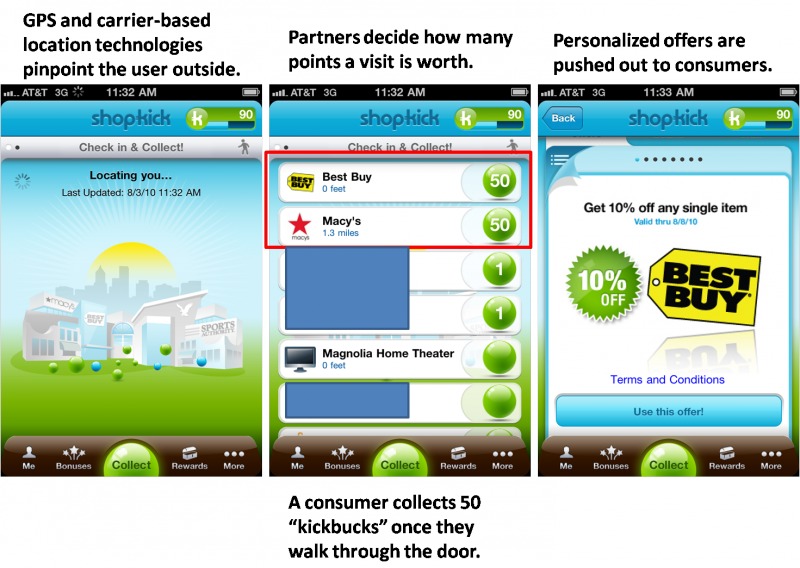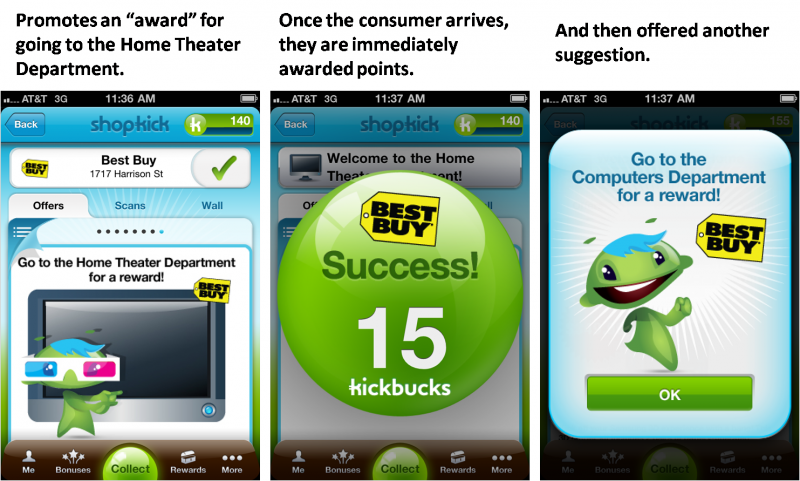Shopkick – New Mobile Service To Drive Legitimate Foot Traffic
I attended the unveiling of shopkick's new location-based technology at the Best Buy around the corner from my office today. Here are the highlights:
- Downloadable application for the iPhone at launch in several weeks; will roll out apps for additional phones.
- If the application is open, it senses where the individual is and what retail partners or other commercial businesses, such as grocery stores, drug stores, restaurants, etc. are nearby. Award points are given when the consumer walks through the door. shopkick installs technology inside the store that acts as a beacon communicating with mobile phones. If the application is open, it will recognize the signal, place the consumer within the store – either at the entrance or a specific department – and award points.

- Once a consumer is inside the store, the service will award points for browsing and for using the built-in barcode scanner to get more product and pricing information.

The solution is integrated at the point of sale (POS) with the consumer's phone number. With purchases, consumers collect both store loyalty points as well as shopkick loyalty points. Loyalty points can be redeemed for special offers or cash – directly from the application. The value of the points in real retailer dollars will be set by the retailer.
What is interesting about shopkick?
- It really knows how to demo a new service. Was the walk-through orchestrated? Yes, but really well done.
- It rewards the consumer for "real" visits to a store – not check-in's from down the street. It rewards visits, browsing, and barcode scanning with speical offers, coupons, and kickbucks. In shopkick's own words, "visits are the offline equivalent of clicks."
- Offers are personalized based on preferences, past shopping behavior, interests, location, and scans.
- Points can be converted to gift cards for a particular retailer instantly – well, one click. Makes it immediate, simple, and contextual – three key elements required for successful mobile services.
- Does it connect the user to the physical environment? Yes – mostly with the location, but likely eventually more so with the products.
- It isn't simply a game that rewards the high score or that offers occasional rewards to some.
- It closes the loop at POS – there weren't many details on this aspect today. We saw the link to the kickbucks account on the receipt – this was good. Imagine, though, following a consumer through the store by monitoring their location. Imagine knowing what they are considering purchasing based on what they scan. You can imagine a virtual following of their thought process. shopkick didn't say it was going to do this, but the technology makes it possible.
- The business model is 100% performance-based with "cost per visit" and "cost per action (= purchase)," with point totals set by the retailer. shopkick takes a percentage of the awarded points in revenue.
What it didn't tell us today that I'd like to know:
- Best Buy and Macy's are its launch partners. Did they invest?
- The cost to install the equipment at each store and time.
- The pace of the rollout.
- What tactics Best Buy will take to support the initiative and drive adoption/download of the application.
- Expected uptake.
- Expected value of a visit, scan, wander, etc.
- How much consumer behavior data is stored? How much is or could be shared among partners in the network?
What will it take for success?
- Reach beyond smartphone platforms, even though most commerce and 2D barcodes are on these devices today.
- A large network of participating retailers, restaurants, etc. If this application only works at Best Buy and a handful of other places, consumers will be less motivated to download and trial the application.
- Support from partners to drive awareness and downloads.
- Real benefits – worthwhile discounts and promotions.
- Retailers must have access to the data in real time (eventually) to create promotions and steer consumers based on what they know about them in a way that isn't creepy.
- Push-based location marketing messages work well where consumer intent is relatively well understood. Will scans, interests, and past behavior be enough?
- Integration with content. Best Buy has great content – consumer reviews, ratings, prices, etc. Would be hard for shopkick to replicate this for all of its partners . . . and its partners will have better information. If I am in a Best Buy evaluating printers, how do I access this rich information — through "my shopping application" or do I switch between this "reward-oriented store guide and wayfinder" and a Best Buy application?
Overall?
One of the most interesting mCommerce plays I've heard about this year. The location detection really works, as do the personalized offers. A performance-based model that retailers control will be attractive. Depending on the deployment costs, shopkick's capacity to build out locations, and network growth, this service may emerge as one of the "must tries" for those looking to drive real and not imaginary traffic into their locations.
